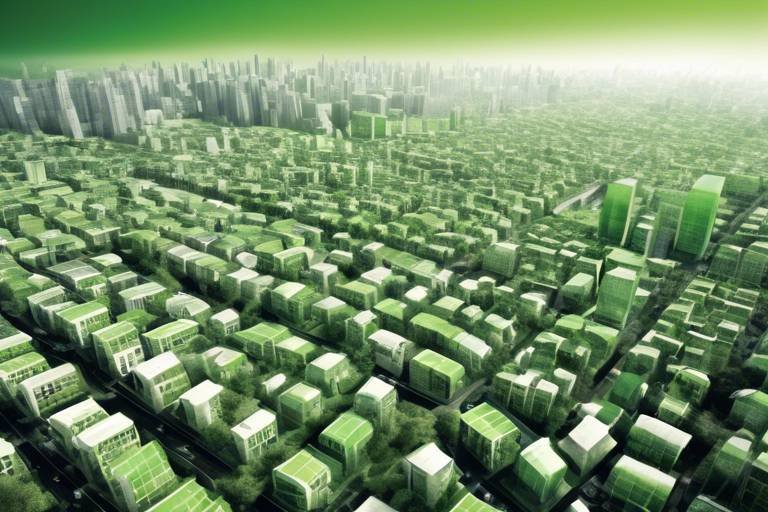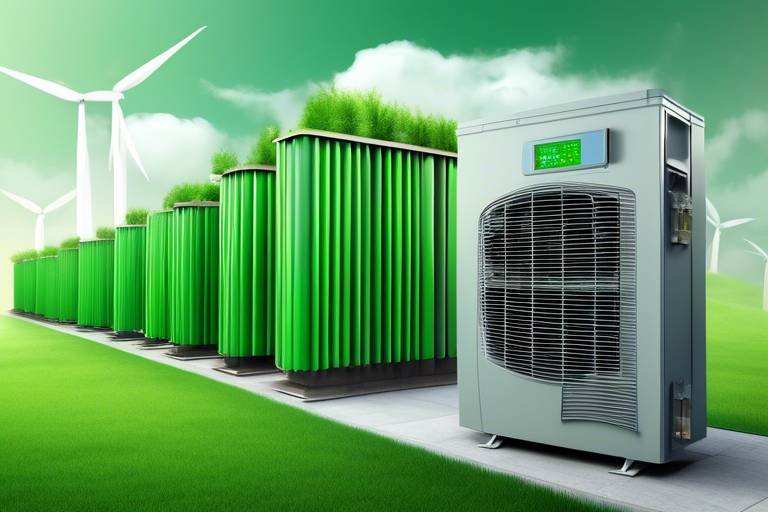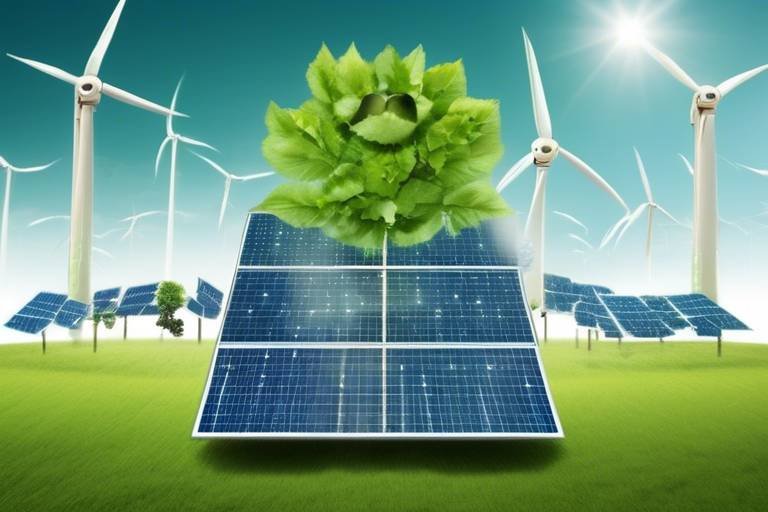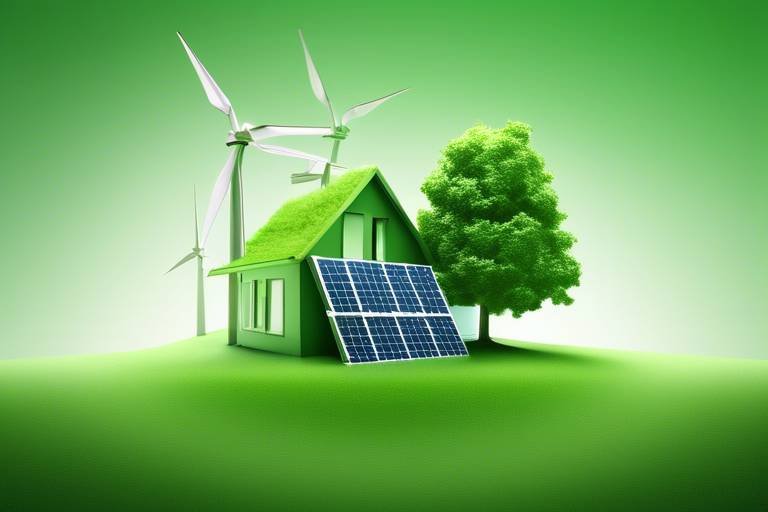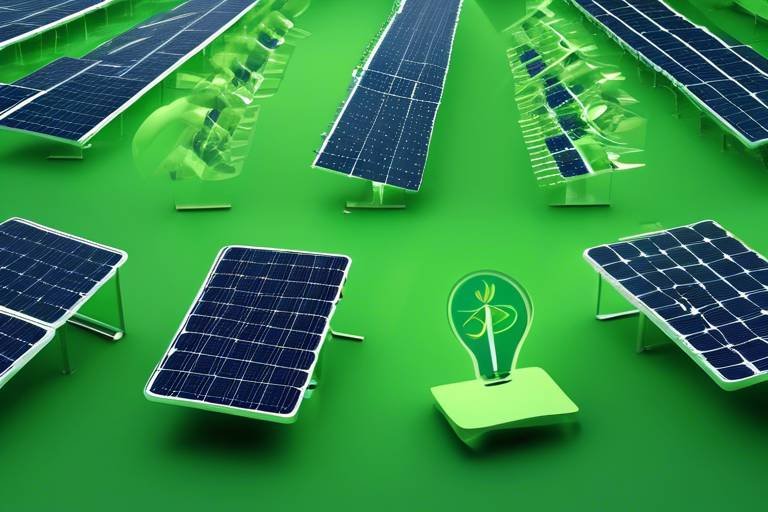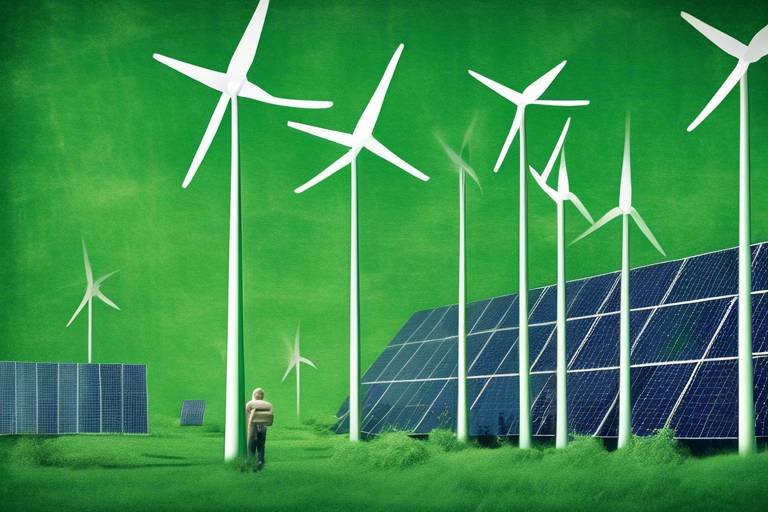Implementing Green Energy in Urban Areas
As cities continue to grow and expand, the need for sustainable energy solutions has never been more critical. Implementing green energy in urban areas is not just a trend; it's a necessity for a healthier planet and a more resilient future. Imagine bustling city streets powered by renewable energy sources, where the air is cleaner, and the energy bills are lower. This transformation is not only possible, but it's also happening right now in various parts of the world. Cities are beginning to embrace solar panels, wind turbines, and innovative technologies that harness the power of nature. But what does this mean for the urban landscape? How can we overcome the challenges that come with such ambitious goals? In this article, we will explore the multifaceted aspects of integrating green energy solutions within urban environments, emphasizing their benefits, challenges, and innovative strategies to promote sustainable living in cities.
Adopting green energy in urban areas offers numerous advantages that ripple through various facets of urban life. First and foremost, it significantly reduces our carbon footprints, making our cities cleaner and healthier. Picture a city where the air is fresher, and the smog that once clouded the skyline has dissipated. This is not just a dream; it can be a reality with the widespread implementation of renewable energy sources. Furthermore, green energy solutions can lead to lower energy costs for residents and businesses alike. By harnessing the power of the sun or wind, cities can reduce their reliance on expensive fossil fuels, allowing savings to be passed on to consumers.
Additionally, the public health benefits are profound. By reducing pollution levels, we can decrease respiratory issues and other health problems linked to poor air quality. The economic benefits are also noteworthy; green energy projects can create jobs, stimulate local economies, and attract eco-conscious businesses. In essence, the shift towards green energy is not just an environmental imperative; it is a comprehensive approach to enhancing urban living.
Despite the myriad benefits, implementing green energy solutions in cities is not without its challenges. Funding is often the most significant hurdle. Many green energy projects require substantial upfront investments, which can be a deterrent for city planners and local governments. Furthermore, existing infrastructure may not be equipped to support new technologies, necessitating costly upgrades. Policy limitations can also pose significant barriers, as outdated regulations may hinder innovation and slow down the adoption of renewable energy sources.
However, these challenges are not insurmountable. With the right strategies and collaborative efforts, cities can overcome these obstacles. For instance, engaging the community through educational initiatives can foster a culture of sustainability, encouraging local residents to advocate for green energy solutions. By understanding the importance of these initiatives, citizens can push for policy changes that support renewable energy projects.
Identifying and securing funding for green energy projects is crucial for their success. Fortunately, there are various funding sources available that can help cities kickstart their green initiatives. These include:
- Government Grants: Many governments offer financial assistance for renewable energy projects, which can significantly reduce the burden on local budgets.
- Private Investments: Partnerships with private companies can provide the necessary capital for large-scale projects.
- Community Crowdfunding: Engaging the local community through crowdfunding can not only raise funds but also build support for sustainability initiatives.
Government programs play a significant role in financing green energy projects. For example, initiatives like tax credits and subsidies can incentivize both businesses and homeowners to invest in renewable energy technologies. Cities that have successfully implemented these programs have seen a marked increase in solar panel installations and wind energy projects. It’s a win-win situation that not only promotes sustainability but also boosts local economies.
The private sector can also contribute significantly to green energy funding. Collaborations between businesses and local governments can lead to innovative financing models that benefit both parties. For instance, companies specializing in renewable technologies can partner with municipalities to create pilot projects, sharing both the risks and rewards. This synergy can accelerate the transition to green energy and create a more sustainable urban environment.
Urban infrastructure must adapt to accommodate green energy technologies. This means integrating solar panels, wind turbines, and other renewable energy systems into existing structures. Cities need to rethink their design and planning processes to ensure that new buildings are equipped for energy efficiency and sustainability. For example, retrofitting older buildings with solar panels can significantly reduce energy consumption while preserving the architectural integrity of the city. The integration of green roofs and energy-efficient appliances can also contribute to a more sustainable urban ecosystem.
Emerging technologies are revolutionizing the way cities harness green energy. Innovations such as smart grids and energy storage systems are at the forefront of this transformation. Smart grids optimize energy distribution and consumption, ensuring that energy is used efficiently and effectively. These systems can adapt to real-time data, allowing cities to manage energy demand more intelligently and reduce waste.
Smart grid technology is a game-changer for urban energy management. By utilizing advanced communication and control technologies, smart grids can optimize energy distribution, reducing outages and improving reliability. Imagine a city where energy flows seamlessly, adapting to changes in demand and supply, and where users can monitor their energy consumption in real-time. This level of efficiency not only enhances the reliability of energy systems but also empowers consumers to make informed decisions about their energy use.
Energy storage systems are essential for balancing supply and demand in urban energy systems. Technologies such as lithium-ion batteries and pumped hydro storage allow cities to store excess energy generated during peak production times and release it when demand surges. This capability is crucial for integrating renewable sources like solar and wind, which can be intermittent. By investing in energy storage solutions, cities can ensure a steady and reliable energy supply, paving the way for a sustainable urban future.
Q: What are the main benefits of implementing green energy in urban areas?
A: The main benefits include reduced carbon footprints, lower energy costs, improved public health, and job creation.
Q: What challenges do cities face when implementing green energy solutions?
A: Major challenges include funding, infrastructure limitations, and outdated policies.
Q: How can cities secure funding for green energy projects?
A: Cities can secure funding through government grants, private investments, and community crowdfunding initiatives.
Q: What role does technology play in urban green energy?
A: Technology, such as smart grids and energy storage systems, enhances energy management and increases the efficiency of renewable energy use.

Benefits of Green Energy
Adopting green energy in urban areas offers a plethora of advantages that can significantly transform the way we live and interact with our environment. One of the most compelling benefits is the reduction in carbon footprints. As cities are often the largest contributors to greenhouse gas emissions, transitioning to renewable energy sources such as solar, wind, and hydroelectric power can drastically lower these emissions. Imagine a bustling city where the air is cleaner, the skies are bluer, and the overall quality of life is enhanced. This is not just a dream; it is a reality that can be achieved through green energy adoption.
Moreover, utilizing renewable energy sources can lead to lower energy costs. Traditional energy sources, often reliant on fossil fuels, are subject to fluctuating prices and can be quite expensive. In contrast, green energy sources, especially solar and wind, have minimal operational costs once established. This means that homeowners and businesses alike can save money on their energy bills, allowing them to allocate funds to other important areas, such as education or healthcare. Imagine being able to invest in your community rather than in energy costs!
Additionally, the shift to green energy can have profound impacts on public health. The burning of fossil fuels releases harmful pollutants that contribute to respiratory illnesses, heart disease, and other health problems. By moving towards cleaner energy sources, cities can improve air quality and, consequently, the health of their residents. A city powered by green energy is akin to a breath of fresh air—literally! The health benefits are not just limited to individuals; they extend to the entire community, reducing healthcare costs and increasing productivity.
In summary, the benefits of integrating green energy solutions in urban settings are substantial. These include:
- Reduced carbon footprints: Cleaner air and a healthier planet.
- Lower energy costs: More money in your pocket for other essentials.
- Enhanced public health: Fewer pollutants leading to better overall health.
These advantages pave the way for a sustainable future, making cities not just places to live, but thriving ecosystems that support both people and the planet. As we look forward, the integration of green energy in urban areas stands as a beacon of hope, promising a cleaner, more sustainable, and healthier world for generations to come.

Challenges in Implementation
Implementing green energy solutions in urban areas is not without its hurdles. While the benefits are undeniable, the path to sustainable living can be fraught with challenges that require careful navigation. One of the most significant obstacles is securing adequate funding. Many green energy projects demand substantial initial investments, which can deter local governments and organizations from pursuing them. Without sufficient financial backing, even the most innovative ideas can remain just that—ideas.
Another major challenge lies in the existing infrastructure. Many urban areas were designed long before the concept of green energy was even a thought. Retrofitting older buildings to accommodate solar panels, wind turbines, or other renewable energy sources can be a complex and costly endeavor. Additionally, the integration of these technologies into the current grid system often requires extensive modifications, which can disrupt daily life and lead to temporary service outages.
Moreover, policy limitations can pose significant barriers to the adoption of green energy. In many cities, regulations are outdated, lacking the flexibility needed to support innovative energy solutions. For instance, zoning laws may not allow for the installation of solar panels on rooftops or the construction of wind farms in certain areas. This can create a frustrating scenario where the technology exists, but the legal framework does not support its implementation.
To tackle these challenges, cities must explore a variety of strategies. One approach is to engage in community outreach to raise awareness and support for green energy initiatives. By educating residents about the benefits, cities can foster a culture of sustainability that encourages local investment and participation. Additionally, establishing partnerships with private companies can open up new avenues for funding and innovation.
Here’s a quick overview of the main challenges:
- Funding: Finding financial resources to kickstart projects.
- Infrastructure: Adapting old systems to new technologies.
- Policy Limitations: Navigating outdated regulations that hinder progress.
In summary, while the journey towards implementing green energy in urban areas is challenging, it is not insurmountable. With the right strategies, community involvement, and innovative partnerships, cities can overcome these obstacles and pave the way for a more sustainable future.
1. What are the main challenges in implementing green energy in urban areas?
The primary challenges include securing funding, adapting existing infrastructure, and navigating outdated policies that may hinder the adoption of new technologies.
2. How can cities overcome funding obstacles for green energy projects?
Cities can explore various funding sources, such as government grants, private investments, and community crowdfunding initiatives, to support their green energy initiatives.
3. Why is infrastructure adaptation important for green energy?
Adapting infrastructure is crucial because many urban areas were not designed with renewable energy technologies in mind. Modifications are necessary to effectively integrate these solutions into existing systems.
4. What role do policies play in the implementation of green energy?
Policies can either facilitate or hinder the adoption of green energy solutions. Outdated regulations may restrict the installation of renewable technologies, making it essential for cities to advocate for policy updates.

Funding Sources
When it comes to implementing green energy solutions in urban areas, one of the most critical aspects is securing adequate funding. Without financial backing, even the most innovative ideas can remain just that—ideas. Fortunately, there are various avenues available for funding green energy projects, each with its unique advantages and challenges. By exploring these options, cities can pave the way for a sustainable future.
One of the primary sources of funding for green energy initiatives comes from government grants. Many local, state, and federal programs are designed to support sustainable projects. These grants can cover a significant portion of the costs associated with implementing renewable energy technologies, such as solar panels and wind turbines. The application process can be competitive, but the payoff is often worth the effort. Cities that have successfully secured government funding have seen a remarkable transformation in their energy landscape.
In addition to government grants, private investments are becoming an increasingly popular source of funding for green energy projects. Many businesses recognize the potential for profit in the renewable energy sector and are eager to partner with local governments to promote sustainable practices. These partnerships can take many forms, from direct investments to collaborative projects that benefit both parties. For example, a tech company might invest in a city’s solar infrastructure in exchange for tax incentives or branding opportunities. Such collaborations not only provide the necessary capital but also foster a sense of community involvement and shared responsibility for environmental stewardship.
Another innovative funding avenue is community crowdfunding. This method allows residents to contribute financially to local green energy projects, creating a sense of ownership and engagement. Platforms like Kickstarter and GoFundMe have made it easier for communities to rally around a common goal. Imagine a neighborhood coming together to fund the installation of solar panels on their community center—this not only reduces energy costs but also strengthens community ties. Crowdfunding can be particularly effective for smaller projects that may not attract the attention of large investors or government grants.
In summary, the landscape of funding sources for green energy projects in urban areas is diverse and dynamic. By leveraging a combination of government grants, private sector investments, and community crowdfunding, cities can unlock the financial resources necessary to implement sustainable energy solutions. The key is to be proactive in seeking out these opportunities and to foster partnerships that align with the broader goals of urban sustainability.
- What types of government grants are available for green energy projects? Government grants vary by region and can include funding for solar installations, energy efficiency upgrades, and research into new technologies.
- How can private companies benefit from investing in green energy? Private companies can gain tax incentives, improve their public image, and tap into the growing market for sustainable products and services.
- What is community crowdfunding, and how does it work? Community crowdfunding allows residents to collectively finance local projects through small contributions, often facilitated by online platforms.

Government Initiatives
The role of government initiatives in promoting green energy in urban areas cannot be overstated. Various programs and policies have been implemented to incentivize the adoption of renewable energy sources, aiming to create a sustainable future for cities. These initiatives often involve a combination of financial support, regulatory frameworks, and public awareness campaigns designed to foster a culture of sustainability. By providing the necessary resources and guidance, governments can significantly accelerate the transition to green energy, making it more accessible and appealing to urban residents and businesses alike.
One of the most impactful government initiatives is the provision of grants and subsidies for renewable energy projects. These financial incentives help offset the initial costs associated with installing solar panels, wind turbines, and other green technologies. For instance, many cities offer tax credits for homeowners who invest in solar energy systems, which can reduce the overall expenditure and encourage more residents to make the switch to renewable energy. Additionally, governments often partner with local organizations to launch educational programs that inform citizens about the benefits of green energy and how they can participate in these initiatives.
Moreover, the establishment of renewable energy targets plays a crucial role in guiding urban development. By setting ambitious goals for reducing greenhouse gas emissions and increasing the share of renewable energy in the energy mix, governments create a framework for accountability and progress. These targets not only motivate local authorities to implement green energy solutions but also foster collaboration between various stakeholders, including businesses, non-profits, and community groups. The success of such initiatives can be seen in cities that have committed to achieving 100% renewable energy by a certain date, demonstrating that with the right policies in place, significant change is possible.
In addition to financial incentives and regulatory frameworks, governments also invest in infrastructure development to support green energy initiatives. This includes the construction of charging stations for electric vehicles, the development of public transportation powered by renewable energy, and the integration of smart grids that optimize energy distribution. A notable example is the implementation of solar energy in public buildings, where city-owned facilities are retrofitted with solar panels to reduce energy costs and serve as a model for private sector adoption.
To summarize, government initiatives are crucial for facilitating the transition to green energy in urban areas. They encompass a wide range of strategies, from financial support and regulatory frameworks to infrastructure development and public education. By fostering collaboration among various stakeholders and setting ambitious renewable energy targets, governments can lead the way towards a more sustainable urban future.
- What types of government initiatives support green energy?
Government initiatives can include grants, subsidies, tax credits, renewable energy targets, and infrastructure investments aimed at promoting sustainable energy solutions. - How do these initiatives impact urban communities?
They help reduce energy costs, lower carbon footprints, and improve public health by promoting cleaner energy sources and encouraging sustainable practices. - Can individuals benefit from government green energy programs?
Yes, individuals can benefit through financial incentives for installing renewable energy systems, as well as educational resources that inform them about sustainable practices. - How can local governments implement these initiatives effectively?
By establishing clear goals, collaborating with stakeholders, and ensuring adequate funding and resources, local governments can effectively implement green energy initiatives.

Private Sector Contributions
The private sector plays a pivotal role in the advancement of green energy solutions within urban areas. Businesses are not just passive observers; they are active participants in the quest for sustainable energy. By investing in renewable energy projects, companies can significantly reduce their carbon footprint while also reaping financial benefits. Think of it as a win-win scenario where the environment and the economy can thrive simultaneously. For instance, tech giants and manufacturing firms are increasingly turning to solar and wind energy, not just to power their operations but also to set a benchmark for sustainability in their industries.
One of the most exciting aspects of private sector involvement is the potential for innovative partnerships between businesses and local governments. These collaborations can lead to groundbreaking projects that might not be possible through public funding alone. For example, a local government might partner with a renewable energy company to install solar panels on public buildings. This not only provides clean energy but also creates jobs and stimulates the local economy. The synergy between public and private sectors can lead to a more resilient urban energy landscape.
Moreover, the private sector is often at the forefront of technological advancements that facilitate the adoption of green energy. Companies specializing in energy storage solutions or smart grid technologies are essential for enhancing the efficiency of urban energy systems. They can provide the necessary expertise and innovation to overcome some of the infrastructural challenges cities face. This technological edge can make a significant difference in how effectively cities can implement green energy initiatives.
To illustrate the impact of private sector contributions, consider the following table showcasing a few successful partnerships between businesses and local governments:
| Partnership | Project Description | Outcome |
|---|---|---|
| City of San Diego & Solar Company | Installation of solar panels on municipal buildings | Reduced energy costs by 30% and cut carbon emissions significantly |
| New York City & Energy Storage Firm | Development of community energy storage systems | Improved energy resilience and reduced peak demand |
| Chicago & Wind Energy Provider | Wind farm development in partnership with local businesses | Generated 50 MW of clean energy, powering thousands of homes |
In conclusion, the private sector's contributions to green energy implementation in urban areas are not only beneficial but essential. They bring in innovation, funding, and expertise that can help cities transition towards a more sustainable future. As we move forward, fostering these collaborations will be crucial in overcoming the challenges that lie ahead in the realm of urban energy sustainability.
- What role does the private sector play in green energy initiatives? The private sector invests in renewable energy projects and partners with local governments to implement sustainable solutions.
- How can businesses benefit from investing in green energy? Investing in green energy can reduce operational costs, enhance brand reputation, and comply with environmental regulations.
- Are there successful examples of public-private partnerships in green energy? Yes, many cities have successfully partnered with businesses to implement solar and wind energy projects, resulting in significant benefits for both parties.

Infrastructure Adaptations
As cities evolve, the need for becomes increasingly apparent, especially when integrating green energy solutions. Urban environments are often characterized by their dense populations and complex layouts, which can pose significant challenges to the implementation of sustainable energy technologies. To effectively harness the power of renewable energy sources like solar and wind, urban infrastructure must undergo thoughtful modifications that not only accommodate these technologies but also enhance overall city functionality.
One of the primary adaptations involves the installation of solar panels on rooftops and other available surfaces. This not only maximizes the use of space but also reduces the urban heat island effect, contributing to cooler city temperatures. Additionally, cities can implement vertical gardens and green roofs, which serve dual purposes: they provide insulation and absorb rainwater, while also supporting biodiversity. These adaptations can transform the urban landscape into a more livable and sustainable environment.
Moreover, integrating wind turbines into urban settings is another innovative adaptation. While traditional wind farms are often located in rural areas, urban wind turbines can be strategically placed on tall buildings or in open spaces. This not only generates clean energy but also raises awareness about the importance of renewable energy in everyday life. However, careful consideration must be given to the design and placement of these turbines to minimize noise and aesthetic concerns.
Another critical aspect of infrastructure adaptation is the enhancement of public transportation systems. Cities can invest in electric buses and trams that run on renewable energy, which significantly reduces greenhouse gas emissions. Additionally, the creation of dedicated bike lanes and pedestrian pathways encourages non-motorized forms of transport, further decreasing reliance on fossil fuels. By fostering a culture of sustainability, urban areas can significantly reduce their carbon footprints.
To facilitate these adaptations, collaboration between various stakeholders is essential. Local governments, private companies, and community organizations must work together to create a cohesive strategy for implementing green energy solutions. This could involve establishing public-private partnerships that leverage resources and expertise from both sectors. For instance, a city might partner with a tech company to develop smart energy management systems that optimize energy use across different infrastructures.
In conclusion, the successful integration of green energy solutions in urban areas relies heavily on thoughtful infrastructure adaptations. By embracing innovative technologies and fostering collaboration among stakeholders, cities can transform their landscapes into sustainable environments that benefit both residents and the planet. As we move forward, it's crucial to recognize that these adaptations are not just necessary; they are an opportunity to redefine urban living for future generations.
- What are some examples of green energy technologies that can be integrated into urban infrastructure? Solar panels, wind turbines, and energy-efficient public transportation systems are key examples.
- How can cities fund these infrastructure adaptations? Cities can secure funding through government grants, private investments, and community crowdfunding initiatives.
- What role do residents play in promoting green energy in their cities? Residents can advocate for sustainable practices, participate in community initiatives, and support local policies that prioritize green energy solutions.

Innovative Technologies
As cities evolve, so too does the technology that powers them. are at the forefront of revolutionizing how urban areas harness and utilize green energy. These advancements not only promise to enhance efficiency but also pave the way for more sustainable living practices. Imagine a city where energy consumption is optimized, waste is minimized, and renewable resources are harnessed seamlessly. This is not just a dream; it’s becoming a reality through the integration of cutting-edge solutions.
One of the most exciting developments in this realm is the implementation of smart grid technology. Smart grids are like the nervous system of a city’s energy infrastructure, capable of communicating in real-time to optimize energy distribution and usage. They leverage data analytics and IoT (Internet of Things) devices to monitor energy flows and adjust supply according to demand. This means that during peak hours, energy can be rerouted to where it’s needed most, reducing waste and ensuring that every kilowatt is utilized effectively. The benefits of smart grids are manifold:
- Improved energy efficiency
- Reduced operational costs
- Enhanced reliability of energy supply
- Increased integration of renewable energy sources
Another groundbreaking advancement is the development of energy storage solutions. These systems are essential for balancing the intermittent nature of renewable energy sources like solar and wind. Just picture a sunny day when solar panels are generating excess energy. Instead of wasting that energy, storage systems can capture and hold it for later use, ensuring that energy is available even when the sun isn’t shining. Various technologies are emerging in this space, including:
| Storage Technology | Description | Applications |
|---|---|---|
| Lithium-ion Batteries | Widely used for their efficiency and longevity. | Residential and commercial energy storage. |
| Pumped Hydro Storage | Uses gravitational potential energy by pumping water uphill. | Large-scale energy storage for grid management. |
| Flywheel Energy Storage | Stores energy in the form of kinetic energy. | Short-term energy storage applications. |
These technologies not only contribute to a more resilient energy grid but also support urban areas in their quest for sustainability. By integrating these systems, cities can significantly reduce their reliance on fossil fuels and decrease greenhouse gas emissions. Moreover, the implementation of innovative technologies fosters economic growth, creating jobs in the renewable energy sector and attracting investments.
As we look towards the future, the synergy between innovative technologies and urban planning will be critical. Cities that embrace these advancements will not only enhance their energy efficiency but will also improve the quality of life for their residents. The transition to a green energy future is not just an environmental imperative; it’s an opportunity for urban areas to redefine themselves as leaders in sustainability.
1. What are smart grids?
Smart grids are advanced electrical grids that use digital technology to monitor and manage the transport of electricity from all generation sources to meet the varying electricity demands of end users.
2. How do energy storage solutions work?
Energy storage systems capture energy produced at one time for use at a later time, balancing supply and demand in energy systems, especially with renewable energy sources.
3. Why are innovative technologies important for urban areas?
These technologies help cities reduce their carbon footprint, enhance energy efficiency, and promote sustainable practices, ultimately leading to improved public health and economic growth.

Smart Grids
Smart grid technology is transforming the way urban areas manage and distribute energy. Imagine a network that not only delivers electricity but also communicates with devices, optimizing energy usage in real-time. This innovative approach enhances efficiency and reliability, making it a game-changer for cities striving to adopt green energy solutions. So, how does it work? Well, smart grids utilize advanced sensors, smart meters, and communication technologies to monitor and manage energy flows. This means that energy providers can predict demand and supply fluctuations, reducing waste and ensuring that energy is available when and where it’s needed most.
One of the most exciting aspects of smart grids is their ability to integrate renewable energy sources. For instance, when solar panels generate excess energy during sunny days, smart grids can redirect that energy to where it’s needed, or store it for later use. This is crucial in urban environments where energy demand can fluctuate dramatically throughout the day. By balancing supply and demand more effectively, smart grids not only help in reducing energy costs but also contribute to a **significant decrease in greenhouse gas emissions**.
Furthermore, smart grids empower consumers by providing them with detailed information about their energy consumption. With smart meters, residents can monitor their energy usage in real-time, making it easier to identify opportunities for saving energy and reducing costs. Imagine knowing exactly how much energy your appliances are using at any given moment—this level of transparency encourages more responsible energy consumption.
The benefits of smart grids extend beyond just energy savings. They also enhance the resilience of urban energy systems. In the event of a power outage, smart grids can quickly identify the source of the problem and reroute power, minimizing downtime. This is particularly important in densely populated urban areas where even a short outage can disrupt daily life and economic activities.
To illustrate the impact of smart grids, consider the following table showcasing the benefits of implementing smart grid technology in urban areas:
| Benefit | Description |
|---|---|
| Enhanced Efficiency | Optimizes energy distribution, reducing waste and lowering costs. |
| Integration of Renewables | Facilitates the use of solar, wind, and other renewable sources. |
| Consumer Empowerment | Provides real-time data, encouraging responsible energy use. |
| Increased Resilience | Quickly identifies and resolves power outages, ensuring reliability. |
In conclusion, smart grids represent a pivotal advancement in how urban areas can harness green energy. By improving efficiency, integrating renewable sources, empowering consumers, and enhancing system resilience, smart grids are not just a technological upgrade; they are a **fundamental shift** towards sustainable urban living. As cities continue to grow and face energy challenges, the adoption of smart grid technology will be essential for creating a greener, more sustainable future.
- What is a smart grid?
A smart grid is an advanced electrical grid that uses digital technology to monitor and manage the transport of electricity from all generation sources to meet the varying electricity demands of end users. - How do smart grids benefit consumers?
Smart grids provide consumers with real-time information about their energy usage, helping them to make informed decisions and reduce their energy costs. - Can smart grids integrate renewable energy?
Yes, smart grids are designed to seamlessly integrate renewable energy sources like solar and wind, making it easier to manage and distribute this energy effectively. - What are the environmental benefits of smart grids?
By optimizing energy use and integrating renewables, smart grids significantly reduce greenhouse gas emissions, contributing to a cleaner environment.

Energy Storage Solutions
In the quest for sustainable urban energy systems, play a pivotal role. These systems are essential for managing the intermittent nature of renewable energy sources like solar and wind. Imagine a bustling city powered by the sun during the day but still glowing brightly at night; that's the magic of effective energy storage! By capturing excess energy when production is high and releasing it when demand peaks, energy storage systems help maintain a balanced and reliable energy supply.
There are several innovative technologies that are transforming the landscape of energy storage. Among the most prominent are batteries, pumped hydro storage, and thermal energy storage. Each of these solutions has its unique advantages and applications:
- Batteries: Lithium-ion batteries are the most common type, widely used in everything from electric vehicles to home energy systems. They are efficient, have a relatively long lifespan, and can be deployed in various scales, making them perfect for urban settings.
- Pumped Hydro Storage: This method involves storing energy by pumping water uphill to a reservoir during low demand and releasing it to generate electricity when needed. While it requires significant infrastructure, it can provide large-scale energy storage and is already in use in many regions.
- Thermal Energy Storage: This approach stores energy in the form of heat, which can then be used for heating purposes or converted back to electricity. Systems like molten salt storage in concentrated solar power plants exemplify this technology.
But how do these solutions work in an urban environment? Cities can leverage a combination of these technologies to create a robust energy storage network. For instance, community battery systems can be installed in neighborhoods, allowing residents to share energy resources and reduce their reliance on the grid. This not only promotes energy independence but also fosters a sense of community as neighbors work together towards a greener future.
Moreover, the integration of smart technology into energy storage systems enhances their efficiency. Smart meters and grid management software can optimize energy flow, ensuring that stored energy is utilized at the right time, reducing waste and costs. This technology not only benefits individual households but also contributes to the overall stability of the urban energy grid.
As cities continue to grow, the demand for reliable and sustainable energy solutions will only increase. By investing in advanced energy storage technologies, urban areas can pave the way for a cleaner, more resilient future. The transition to green energy is not just a trend; it’s a necessity for the health of our planet and the well-being of future generations.
- What are energy storage solutions?
Energy storage solutions are technologies that capture and store energy for later use, helping to balance supply and demand in energy systems. - Why are energy storage solutions important in urban areas?
They help manage the intermittent nature of renewable energy sources, ensuring a reliable energy supply and reducing reliance on fossil fuels. - What types of energy storage are most commonly used?
The most common types include batteries, pumped hydro storage, and thermal energy storage. - How can communities benefit from energy storage?
Communities can share resources through community battery systems, enhancing energy independence and fostering collaboration among residents.
Frequently Asked Questions
- What are the main benefits of implementing green energy in urban areas?
Implementing green energy in urban areas brings a multitude of benefits. First and foremost, it significantly reduces carbon footprints, contributing to a cleaner environment. Additionally, it can lead to lower energy costs for residents and businesses alike. Not to mention, the transition to green energy can enhance public health by reducing pollution and promoting cleaner air quality. These advantages create a more sustainable and livable urban environment.
- What challenges do cities face when implementing green energy solutions?
While the benefits are compelling, cities often encounter several challenges when trying to implement green energy solutions. Funding is a major hurdle, as securing the necessary financial resources can be difficult. Infrastructure also poses a challenge, as many urban areas need significant modifications to accommodate new technologies. Additionally, policy limitations can slow down the adoption of green energy initiatives, making it essential for cities to strategize and overcome these obstacles.
- How can cities secure funding for green energy projects?
Securing funding for green energy projects can be achieved through various channels. Government grants are a vital resource, as many local and national programs are designed to support sustainable initiatives. Private investments also play a crucial role, with businesses increasingly looking to partner with local governments on green projects. Moreover, community crowdfunding initiatives can mobilize local support and resources, making it easier to finance these important projects.
- What role do government initiatives play in promoting green energy?
Government initiatives are pivotal in promoting green energy in urban areas. They often provide the necessary funding and resources that make projects feasible. Successful government programs can serve as models for other cities, showcasing effective strategies and solutions. By facilitating partnerships and offering incentives, government initiatives can significantly accelerate the adoption of green energy technologies.
- How do smart grids enhance urban energy management?
Smart grids are game-changers in urban energy management. They optimize the distribution and consumption of energy, allowing for more efficient use of resources. By integrating advanced technologies, smart grids can respond dynamically to energy demands, reducing waste and improving reliability. This not only benefits consumers with lower energy costs but also supports the overall sustainability goals of urban areas.
- What types of energy storage solutions are available for urban areas?
There are several energy storage solutions available that are particularly beneficial for urban settings. These include battery storage systems, which can store excess energy generated during peak production times for later use. Other technologies, such as pumped hydro storage and thermal energy storage, also play important roles in balancing supply and demand. By effectively managing energy storage, cities can enhance their resilience and sustainability.

